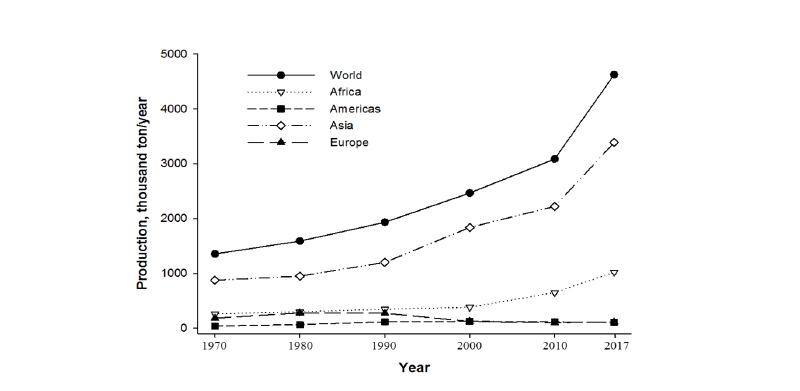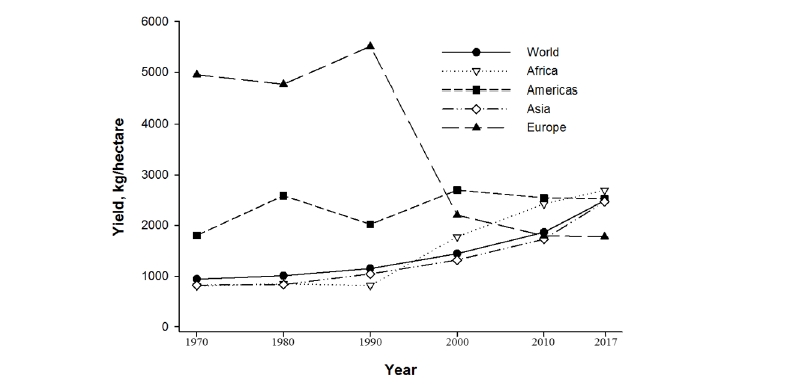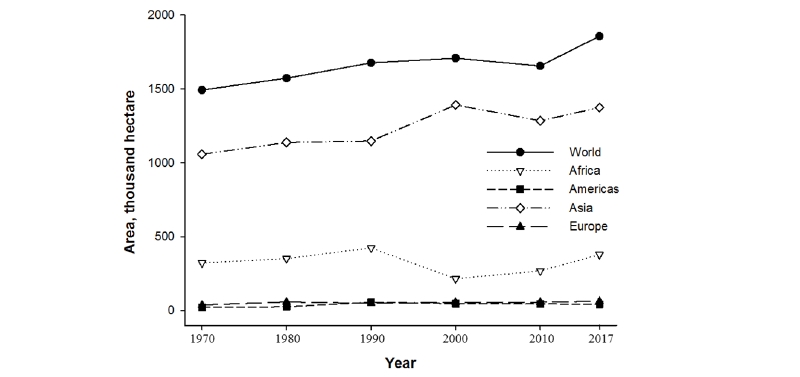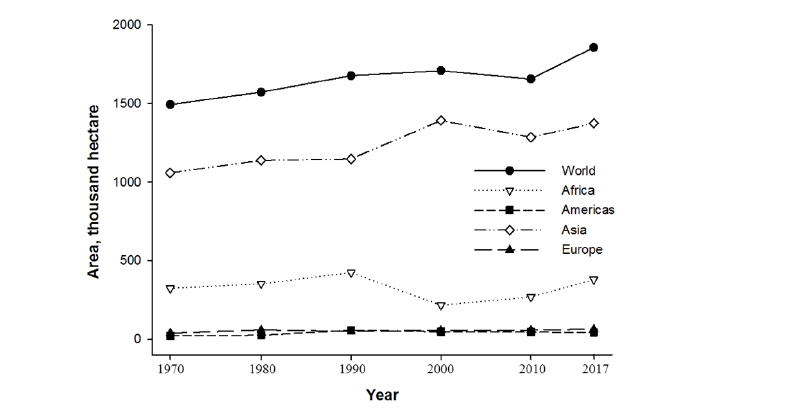Introduction
Chilli pepper (Capsicum annuum L.) is the fruit of plants from the which relates to the family . This crop originated from Mexico, Central America. Nowadays, chilli pepper is cultivated all around the world, widely used in many cuisines as a spice and in pharmacy for the extraction of bioactive compounds known as . Chilli pepper fruits constitute large amounts of beneficial compounds including carbohydrates, minerals, proteins, amino acids, antioxidants, phytochemicals, and vitamins (Olatunji and Afolayan, 2018). In the last years, the demand for healthy, nutrient abundant, eco-friendly and tasteful chilli pepper is increasing, proportionally, the production is gradually expanding in many regions of the world. For instance, dry chilli pepper production has increased from 1.4 million ton in 1980 to 4.6 million ton in 2017 in the world (FAO, 2019), the main part of this crop has been producing in Asia, refer to Fig. , 2, and 3 for chilli pepper production, yield, and occupied areas in different regions of the world. Asia is the main producer and exporter of chilli pepper, in fact, it is produced as an important commercial crop in many countries. Three Asian countries produce the main part of chilli pepper in the region, namely, India - 2,096 thousand tonnes, Thailand - 349.6 thousand tonnes and China - 314 thousand ton (Fig. 4). Korea ranks fourth in green chilli pepper production among Asian countries, producing 221.9 thousand tonnes in 2017 according to the FAO statistics.
Pepper is a warm-season crop possessing vulnerability features to abiotic and biotic factors (Airaki et al., 2012). Small changes in the environment affect nutrient uptake and growth of chilli pepper, although these two processes are physiologically fully independent (Ropokis et al., 2018). On the other hand, major climatic changes have serious impact on plant existence, thereby imposing stress conditions that may destroy the physiological processes including metabolism, photosynthesis, transpiration, etc.
There are many factors having an impact on pepper yield and the most important constraints are associated with water or nutrient deficiency (Abayomi et al., 2012). Chilli pepper grows well in tropical climate due to the adaptation in warm and humid regions with temperatures ranging from 18 to 30℃. Well-drained moisture-holding loamy soil is considered fit for optimal growth and production of chilli pepper. Also, it requires higher amounts of N, P and K, and other micronutrients during early and late reproductive stages, deficiency of nutrients at these periods affects the generative processes and eventually reduce the crop yield (Mali et al., 2019). The root system is not well-developed in chilli pepper which reduces the ability to uptake maximum nutrients for normal growth. Thus, it is important to supply a sufficient amount of nutrients to the root zone to improve the nutrient use efficiency and crop yield.
Notably, organic vegetable production is thriving rapidly in recent years due to the higher demand for natural products by consumers. However, a large amount of chemical fertilizers is being applied to soil in order to increase a crop yield which have an enormous harmful impact to the environment and reduce fertilizer use efficiencies (Guignard et al., 2017). The use of chemical fertilizers and pesticides should be decreased in modern agriculture, simultaneously maintaining or even enhancing crop yield. Moreover, a continuous increase of the cost of chemical fertilizers forces producers to find alternative technologies and management system to improve fertilizer use efficiency in crop production. Nowadays, the application of organic manure is critical than ever because it contributes to balance nutrients availability and crucial for restoring soil fertility, particularly in depleted soils (Pane et al., 2013; Scotti et al., 2016). Incorporation of organic amendments such as bacterial fertilizers, organic and inorganic biomolecules for the production of compost manure aimed to protect crops from bacterial and fungi diseases plus promote growth and yield.
Taken together the above-mentioned arguments, it is prudent to study the effects of various rates of organic manure and fertilizers supply on vegetative and generative parameters of chilli pepper under different environmental conditions which are important to prevent any adverse effects. Thus, the objectives of this review article were to investigate (1) effect of elevated temperature on vegetative and generative organs of chilli pepper; (2) exposure of different rates of chemical fertilizers and organic amendments to the performance of chilli pepper.
Impact of heat stress on chilli pepper performance
Climate change is a serious threat to crops, causing a negative impact on the quantity and quality of yield. The increase of the CO2 along with other greenhouse gases may cause an increase of more than 2℃ in mean global temperature by the end of this century (IPCC, 2013). Also, many extreme climatic events have arisen as a consequence of the rise in the concentration of CO2 and other exhaust gases. Since the further increase of the atmospheric CO2 concentration up to 1000 μmol mol−1 according to IPCC (2013), probably may worsen the anticipated climate scenario. The consequences of climate change including - droughts, soil salinity, flooding, desertification, high radiation, extreme heat are very serious for crop production, causing great challenges for food security (Röth et al., 2015). An increase in mean annual temperatures and heat waves might destroy physiological processes in plants (Jiang and Huang, 2001).
According to the recent researches of Pérez-Jiménez et al. (2019), a heat shock (43℃) and a high CO2 concentration (1000 μmol mol-1) exposed on pepper in a controlled environment augmented photosynthesis and nitrate concentration, particularly at the elevated CO2 concentration. However, the authors restricted with the experiments only on the vegetative growth in their study; it is well-known heat triggers many negative impacts to the generative organs. It is pivotal to note that the heat-threshold level is different among developmental stages of chilli pepper and the expected global warming may cause destructive impacts to the production of chilli pepper, seriously disrupting the pollination processes (Hedhly et al., 2009; Mateos et al., 2013). Furthermore, heat stress deteriorates protein stability level in a plant cell, exposing hydrophobic patches that may lead to the congestion of denatured proteins (Kim and Hwang, 2015). The response reaction to heat is a complex process in the plant, triggering the activation of numerous regulatory and signalling pathways that end up to a metabolic adjustment to maintain cell survival (Röth et al., 2015).
Extreme heat temperature substantially decreases photosynthesis (Hemantaranjan et al., 2014) due to a shortage in electron transport activity and Rubisco activase capacity (Sage and Kubien, 2007). In contrast, Rizhsky et al. (2002) reported that high temperatures don't cause any changes in photosynthesis along with the intensification of the stomatal conductance. Chilli pepper growth intensifies at a temperature range of 20 - 30℃ (Li et al., 2015), however, temperature greater than 32℃, especially at the anthesis, harms to pollen survival (Challinor et al., 2007). The experiment conducted by Lee et al. (2018) revealed that exposure on chilli pepper by extreme higher temperatures and increased CO2 concentration shortened the ripening period and reduced the fruit yield. Furthermore, negative effects were also observed on the morphogenesis, photosynthesis, and fruit characteristics. The results are seen in reducing crop yield if adaptable cultivars are absent since extreme heat negatively affects the reproductive development of the plant (Kafizadeh et al., 2008).
As the temperature continues to rise due to future climate change, the adverse effects of high temperature will create a great demand for heat-tolerant cultivars to maintain production. Considering the fact is the main part of chilli pepper is produced in a field, summer production will be impossible in many parts of the world without heat-tolerant crops. Wild relatives of Capsicum spp. need to be tested for beneficial traits to set fruits even under high-temperature conditions, these values would be precious for a breeding program to create high-temperature tolerant cultivars. As expected climate change exacerbates adverse effects of abiotic and biotic factors, future crop cultivars should be more tolerant to the changing environment for the sustenance of the production. Crop wild relatives are the natural source to pursue the beneficial traits which are capable to withstand under stress conditions and these traits might be transferred by modern molecular and genomic technologies (Mammadov et al., 2018).
Sahitya et al. (2019) reported that drought tolerance is one of the important characteristics of chilli pepper under climate change. Aquaporin gene expressions were revealed in drought-tolerant genotypes as a part of molecular processes maintaining drought tolerance. Walters and Jha (2016) informed that chilli pepper performs well in hot and dry environments of Afghanistan with comparably lower post-harvest losses than other fruit crops. Probably, heat-tolerant chilli pepper varieties have been selected and developed gradually in Afghanistan's harsh soil-climatic conditions. The authors also declared that the period from flowering to fruiting is the most critical for chili pepper, exhibiting high sensitivity to limited and excessive water in the root zone. Earlier, Dagdelen et al. (2004) analysed the sensitivity of chilli pepper to moisture stress and confirmed that chili pepper is especially sensitive to moisture stress and in order to get high yield and fruit quality it is essential to maintain consistent moisture in the root zone throughout the growing season.
According to the study of Guo et al. (2014), high temperature is a favour for plant growth, however, the threshold temperatures above 32℃ can cause serious pollination and fertilization problems for chilli pepper. However, Pérez-Jiménez et al. (2019) reported that even high temperatures did not cause any considerable stress when proper irrigation and fertilization were applied during the plant vegetation period. The authors also revealed that photosynthesis and nitrate concentration were higher under high temperatures, exhibiting a better performance of the plant in regards to carbon fixation and storage, and hence growth. In accordance with this study, Wang et al. (2018) reported that the mitigation of environmental impacts might be possible based on the best nutrient and crop management practices. In contrast, Lee et al. (2018) reported that the yield of hot pepper in the ambient + 3.4℃, CO2 - 540 μmol/mol and ambient + 6.0℃ and CO2 - 940 μmol/mol conditions were decreased by 21.5% and 89.2% when compared to the control, respectively. Whereas, the plant growth parameters were two-fold higher under the elevated temperature conditions. Pagamas and Nawata (2008) tested heat stress during the seed formation period of chilli pepper and revealed that exposure of high temperature after the anthesis adversely affected fruit growth, seed yield, and seed quality of chili pepper. These studies also confirmed the hypothesis that higher temperature due to climate change positively affects plant vegetative parameters; however, it has a negative impact on the reproductive development of chilli pepper.
Nutrient use efficiency
Chilli pepper requires essential macroelements – N (nitrogen), P (phosphorous), K (potassium) and many microelements including Ca (calcium), Mg (magnesium), S (sulphur), B (boron), Fe (iron), Cl (chlorine), Mn (manganese), Cu (copper), Zn (zinc), Ni (nickel), and Mo (molybdenum) for normal growth and development. The plant generally obtains these elements from the soil. The crop productivity usually is affected by the deficiency or excessive availability of these elements in the root zone, on the other hand, toxic mineral elements including As (Arsenic), Hg (), Cd (), and Pb () trigger an adverse effect for plant survival (Abayomi et al., 2012).
Abiotic and biotic factors have a considerable effect on plant performance, fruit quantity, and quality. According to the studies of Ropokis et al. (2018), uptake concentrations of nutrients in different pepper varieties were at different ratios even under the same environmental, nutritional and water regime conditions. Salinity has a considerable impact to fruit nutrient content of pepper, reducing concentrations of macro and microelements as well as amino acid profiles (Piñero et al., 2019). The N content substantially declined when chilli pepper exposed to high salt stress, however, the adverse effect was partly mitigated by balanced N supply (Munns and Tester, 2008).
Wang et al. (2018) reported that N fertilizers accounted for 64.4% of global warming, 78.6% for acidification and 97.9% for eutrophication potential, respectively, while structural materials for greenhouse accounted for 58.6% of the total energy depletion. Plant response to high CO2 and elevated temperature have been extensively studied, however, there are no any studies of their combined effects on plant performance or how these stressors are reacted by the overuse of N, another major pollutant. N is a mobile element circulating between the atmosphere, the soil and living organisms. Being as one of the widely distributed elements in nature, N is the most important mineral elements for plant growth (Glass, 2003). Especially, it is indispensable in cell formation and involved in the biosynthesis of many important compounds. Normal functioning of plant physiological processes such as photosynthesis, chlorophyll content, stomatal conductance, the maximum potential quantum efficiency of photosystem II, and growth associated with an adequate level of N in the cells. N occurs mainly in the form of NO3 or NH4 ions in nature. N deficiency is considered one of the main limiting factors in crop production, resulting in a serious imbalance, reduce growth and crop yield (Rubio-Wilhelmi et al., 2011). An excessive amount of N was applied to get a high crop yield in the past, but this approach generated considerable adverse impacts to the environment, such as water and soil contaminations. In order to avoid environmental pollution due to excessive application of fertilizers, reduced amount of N fertilizer is now being implemented into crop production systems. In many cases, it is difficult to achieve a balance between plant N demand and environmental safety. An efficient N use under low N supply is not always the right solution to the problem, which was practiced in the last decade (Zhao et al., 2014). On the other hand, N starvation induces adverse impact in physiological processes of chilli pepper such as reduce in the photosynthesis rate and chlorophyll content accompanied by increases in lipid peroxidation and the levels of anions, cysteine, leucine, and phenylalanine.
Potassium (K) is an essential nutrient element that has substantial effects on growth, yield, and quality production of agricultural crops including chilli pepper (Mardanluo et al., 2018). The yield and fruit quality parameters including fruit length/diameter ratio, fruit dry matter percentage, fruit vitamin C, total soluble solids, and titratable acidity in chili pepper were higher under application of 300 and 400 mg K L−1 in a nutrient solution, respectively. The results indicate that for better growth and quality production of pepper, higher levels of K in nutrient solutions can be beneficial.
Kim et al. (2018) analysed the contents of 38 primary metabolites and 9 minerals in the leaves and roots of pepper to study metabolic responses to the deficiency of N, P, K, Ca, and Mg. The authors revealed that N deficiency reduced amino acids and organic acids in both plant parts. On the other hand, P-, K-, Ca- or Mg-deficiency showed significant increases of amino acids and organic acids in the roots. Particularly, the level of γ-aminobutyric acid, an amino acid that helps protect against biotic and abiotic stresses, was increased threefold in leaves under K-deficient conditions and sixfold in roots under P-, K-, Ca-, or Mg-deficient conditions. Souri and Sooraki (2019) studied the effects of foliar application with constant 0.2% concentration of chemical NPK (N20 : P10 : K20) and organic fertilizers of Biomin (an organic aminochelate fertilizer), Humifolin (a humic acid based fertilizer). Quality traits (leaf area, chlorophyll index, root, and shoot biomass, and leaf concentration of soluble sugars, N, K, Ca, and Zn) were best improved by foliar application with Biomin amino chelate followed by Humifolin fertilizer. But, their mixture had reduced growth parameters of chilli pepper indicating possible negative interaction when these two organic fertilizers are mixed.
Casierra-Posada et al. (2018) reported that iron (Fe) is an essential element for chilli pepper, but it’s high concentrations adversely affect to the plant growth and yield. The chlorophyll content index, leaf area, total dry weight, water uptake, water use efficiency, relative growth rate, absolute growth rate, and net assimilation rate were found to be inversely proportional to the amount of Fe added. Based on the initial analyses, it can be concluded that pepper plants are very sensitive to the excessive application of Fe in the substrate.
Angulo-Castro et al. (2017) reported that Capsicum annuum L was inoculated with plant growth promoting rhizobacteria (PGPR) and arbuscular mycorrhizal fungi (AMF). P61 bacterium and H1 AMF consortia were the most effective microorganisms for jalapeno pepper, whereas R44 bacterium and AMF H3 and H1 were the most effective for chilli peppers. While studying the effect of microorganisms on nutrient use efficiency of chilli pepper, Khenaka et al. (2019) observed enhanced nutrient availability for the plant uptake due to the abundance of bacterial diversity in the soil.
Effects of organic amendments on plant performance and soil characteristics
Different organic amendments including manure, mulch, or compost play an important role in maintaining soil fertility and nutrient retention (). Soil chemical properties including N content and the C : N ratio is influenced by incorporation of organic amendments. On the other hand, the application of more stable compound such as biochar has many beneficial impacts to improve soil functions including an increase in soil pH and water holding capacity, the addition of basic cations and micronutrients (). However, the single application of biochar cannot provide enough nutrients for plant growth (Syuhada et al., 2016). Whereas, Kumar et al. (2018) informed that priming potential of biochar improved soil physical/chemical properties, nutritional level, pH and EC, resulted in multi-year improved pepper productivity and detoxified soil contaminants, enhanced resistance to diseases and pests. The authors also suggested that farmers can increase the profitability of chilli pepper production due to the implementation of biochar amendment. Minor changes in total N concentrations in the soil also affects to the leaching and uptake by plants. Soil pH levels, chemical, and biological characteristics are influenced by organic manure addition. Marzaioli et al. (2018) reported that the addition of biochar to soil results in to increase soil organic C pool, enhances crop productivity and improves C terrestrial sink and the single char application positively affected soil respiration, nitrogen mineralization, and potential nitrification. These preliminary results suggest that the soil amendment with biochar is a potentially useful practice in greenhouse agriculture, yet further experimentation is necessary to assess optimal amounts for better crop productivity and soil quality.
Although, chemical NPK fertilizer is considered as the main source of nutrients for plant growth, organic manure constitutes large amounts of N, P, and K nutrients. Furthermore, organic manure maintains slower usage of nutrients, reducing the loss by leaching or other chemical processes. The soil in a greenhouse is prone to an impoverishment of organic carbon and other essential nutrients due to the high amount of crop removal and decomposition rate. Moreover, the incorporation of organic manure into soil improves soil fertility by increasing beneficial microorganisms, nutrient status, and soil physical and chemical properties (Silva et al., 2019). According to pepper yield enhancement strategies, application of organic amendments has been proved to be indispensable for soil richness, while maintaining sustainable crop production and yield increase.
Conclusion
Projected climate change is expected to affect adversely on yield and quality of fruit crops, including chilli pepper, and it is important to discover heat stress-tolerant crop varieties or alternative agrotechnologies to maintain productivity. If the temperature threshold exceeds the limit at anthesis, probably, the best solution is changing planting and harvest date, as in general yield and quality are reduced when the temperature exceeds the threshold. There is a great demand to create heat-tolerant cultivars based on the hybridization with wild crop relatives, thus the impact of exceeding the threshold temperature might be reduced, since tolerance of chilli pepper to harsh environmental conditions is variety specific.
In conclusion, strategies based on effective nutrient supply, irrigation techniques, and ameliorative tools are necessary to maintain the sustainability of the production of chilli pepper. Also, the application of organic manures needs to be improved to enhance the resilience of the crop to adverse environmental impacts. In the future, it is essential to develop a prediction model according to the effects of various environmental factors on crop growth and yield associated with nutrients and water supply regime.
Acknowledgements
This study was carried out with the support of “Cooperative Research Program for Agricultural Science & Technology Development (Project No. PJ01283702)” Rural Development Administration, Republic of Korea.
Authors Information
Botir Khaitov, https://orcid.org/0000-0001-6314-1597
Mirjalol Umurzokov, https://orcid.org/0000-0001-8148-8041
Kwang-Min Cho, https://orcid.org/0000-0003-0537-2164
Ye-Jin Lee, https://orcid.org/000-0003-4415-846X
Kee Woong Park, https://orcid.org/0000-0003-0053-9543
Jwakyung Sung, https://orcid.org/0000-0002-0758-6644








